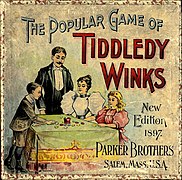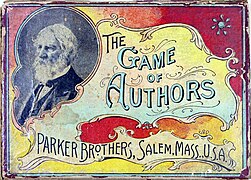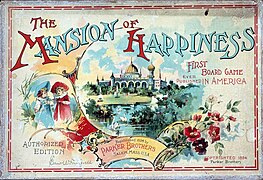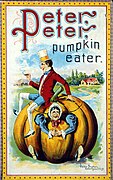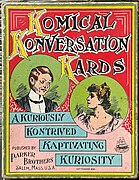Parker Brothers
 Logo designed by Arnold Ferdinand Arnold, 1964 | |
| Formerly | George S. Parker Company |
|---|---|
| Company type | Division |
| Industry | Entertainment |
| Founded | 1883 |
| Founder | George Swinnerton Parker |
| Defunct | December 14, 1998 (company) |
| Fate | Purchased by Hasbro in 1991; merged with Milton Bradley to be reincorporated as "Hasbro Games" (now Hasbro Gaming) in 1998. Remained as a brand until 2009 |
| Successor | Hasbro Games |
| Headquarters | , US |
| Products | Board games Electronic games |
| Brands | |
| Parent | Hasbro |
Parker Brothers (known by Parker outside of North America) was an American toy and game manufacturer which in 1991 became a brand of Hasbro. More than 1,800 games were published under the Parker Brothers name since 1883.[1] Among its products were Monopoly, Clue (licensed from the British publisher and known as Cluedo outside of North America), Sorry!, Risk, Trivial Pursuit, Ouija, Aggravation, Bop It, Scrabble (under a joint partnership with Milton Bradley in the United States and Canada), and Probe. The trade name became defunct with former products being marketed under the "Hasbro Gaming" label, with the logo shown on Monopoly games.
History
[edit]
Parker Brothers was founded by George Swinnerton Parker.[2] Parker's philosophy deviated from the prevalent theme of board game design; he believed that games should be played for enjoyment and did not need to emphasize morals and values. He created his first game, called Banking, in 1883 when he was 16.[3] Banking is a game in which players borrow money from the bank and try to generate wealth by guessing how well they could do. The game includes 160 cards which foretell their failure or success. The game was so popular among family and friends that his brother, Charles Parker, urged him to publish it. George approached two Boston publishers with the idea, but was unsuccessful. Not discouraged, he spent $40 to publish 500 sets of Banking.[3] He eventually sold all but twelve copies, making a profit of $100.
Parker founded his game company, initially called the George S. Parker Company, in his hometown of Salem, Massachusetts in 1883.[4] When George's brother Charles joined the business in 1888, the company's name was changed to its more familiar form. In 1898 a third brother, Edward H. Parker, joined the company. For many years, George designed most of the games himself, and wrote all the rules. Many games were based on important events of the day: Klondike was based on the Klondike Gold Rush, and War in Cuba was based on the impending Spanish–American War.[5]
The game industry was growing, and the company was becoming very profitable. In 1906, Parker Brothers published the game Rook and it became the bestselling game in the country.[5] During the Great Depression, a time when many companies went out of business, Parker Brothers released a new board game called Monopoly. Although the company had originally rejected the game in 1934, they decided to publish it the next year.[6] It was a success, and the company had difficulty keeping up with demand. The company continued to grow throughout the next several decades, producing games including Cluedo (released as Clue in North America), Risk, and Sorry![5]
Parker Brothers marketed its first jigsaw puzzle in 1887. Parker also produced children's puzzles, as well as the Climax, Jig-A-Jig, Jig Wood, and Paramount lines. According to Jigsaw Puzzles: An Illustrated History and Price Guide, by Anne D. Williams, Parker Bros. closed the Pastime line in the 1950s and their die-cut puzzles were phased out in the late 1970s.[7]
Even after George Parker's death, the company remained family-owned until 1968 when General Mills purchased the company.[2] After this, Parker Brothers produced the first Nerf ball.[5] In the UK during the 1970s, Parker Brothers sold the rights of some games to the games division of Palitoy (also a General Mills company),[8] and produced a variety of releases such as Escape from Colditz.[9] In 1977, the company built its headquarters in Beverly, Massachusetts.[10]
In early 1983, Parker Brothers spent US$15 million establishing a book publishing branch;[11] their first titles featured the American Greetings franchises, Care Bears and Strawberry Shortcake.[11][12] The branch published twelve titles by February 1984; sales of these books totaled 3.5 million units.[13] Parker Brothers also operated a record label around the same time; one of its releases, based on Coleco's Cabbage Patch Kids and involving Tom and Stephen Chapin titled Cabbage Patch Dreams,[13] was certified Gold by the Recording Industry Association of America (RIAA) in July 1984.[11]
In 1985, General Mills merged the company with their subsidiary Kenner; this new company, Kenner Parker Toys Inc., was acquired by Tonka in 1987.[14] In 1988, Parker Brothers struck a deal with Martindale/Gilden Productions to develop television game shows, such as Boggle.[15]
Tonka, including Parker Brothers, was bought in 1991 for about $516 million by Hasbro which also owned the Milton Bradley Company.[16] Following the acquisition, Parker Brothers continued to have its corporate offices in Beverly, but production of the games were moved to Milton Bradley's headquarters in East Longmeadow.[17] In 1998, Parker Brothers and Milton Bradley were consolidated at the new Hasbro Games campus (based in the former address of Parker Brothers' headquarters) to merge together and form Hasbro Games.[18] Milton Bradley and Parker Bros. subsequently turned into two separate brands of Hasbro before being retired in 2009 in favor of the Hasbro brand.
Video games
[edit]Parker Brothers had a reputation for quality family-oriented and licensed games.[19] The company released Merlin in 1978, and sold 700,000 units before Christmas and had a sales total of $100 million in 1979.[20]
It began to produce electronic versions of popular Parker Brothers board games in the late 1970s. The company ventured into the toy market with the electronic action figure, Rom the Spaceknight, in 1979. Although the toy proved a failure, the licensed comic book published by Marvel Comics ran for years after the toy was discontinued.
Parker Brothers spent $50,000 to reverse-engineer Atari's hardware to produce its own cartridges. The company was able to obtain the license for Star Wars games as Kenner Products was also owned by General Mills. Parker Brothers earned $74 million from cartridge sales between June and December 1982.[21] Other Parker Brothers video games included many popular arcade games such as Konami's Frogger, Nintendo's Popeye, and Gottlieb games such as Q*bert and Reactor.
Some games published
[edit]Gallery
[edit]-
Tiddledywinks
-
Authors
-
Billy Bumps
-
Touring
-
Jake Strauss
-
Pictures from the War
-
Napoleon, the Little Corporal
-
Mansion of Happiness
-
Peter Peter
-
Peter Coddles
-
Komical Konversation
References
[edit]- ^ "Parker Brothers". Facebook. Archived from the original on October 17, 2015. Retrieved July 11, 2013.
- ^ a b McCabe, Kathy (December 7, 2003). "For love of the games". The Boston Globe. Archived from the original on December 25, 2022. Retrieved August 20, 2020.
- ^ a b "The History of Toys". Archived from the original on October 12, 2007.
- ^ 90 Years of Fun, 1883-1973: the History of Parker Brothers. 1973.
- ^ a b c d "Milestones in life of Parker Brothers Game Company". The Pittsburgh Press. December 6, 1983 – via Newspapers.com.
- ^ "Monopoly Board Game – Parker Brothers". Archived from the original on June 15, 2007.
- ^ "Risk Online Game Reviews". Retrieved April 25, 2016.
- ^ Wojahn, Ellen (2003). The General Mills/Parker Brothers Merger: Playing by Different Rules. Beard Books. p. 107. ISBN 978-1-58798-182-1. Archived from the original on October 2, 2024. Retrieved August 27, 2024.
- ^ Mackenzie, S. P. (2006). The Colditz Myth: British and Commonwealth Prisoners of War in Nazi Germany. Oxford University Press. p. 14. ISBN 978-0-19-920307-9. Archived from the original on October 2, 2024. Retrieved August 27, 2024.
- ^ Forman, Ethan (March 2, 2011). "Brokers look to reposition former Parker Brothers building". Salem News. Archived from the original on June 29, 2023. Retrieved August 21, 2020.
- ^ a b c Wojahn, Ellen (1988). "Fold". Playing by Different Rules. American Management Association (amacom). p. 217. ISBN 0-8144-5861-0.
- ^ Dougherty, Philip H. (February 8, 1983). "Parker Bros. adding book publishing line". The Miami News. New York Times News Service. p. 8A. Retrieved August 5, 2010.[permanent dead link]
- ^ a b Gorov, Linda (February 9, 1984). "Parker Brothers giving (children's) music market a spin". The Boston Globe. The New York Times Company. Archived from the original on April 14, 2013. Retrieved September 21, 2010.
Parker's move comes on the heels of its 1983 entry into children's books. Its 12 books about Care Bears and Strawberry Shortcake sold an unprecedented 3.5 (million units).
- ^ Adelson, Andrea (September 5, 1987). "Kenner Takes Proposal of $51 a Share by Tonka". The New York Times. ISSN 0362-4331. Retrieved August 20, 2020.
- ^ "Boggle board game set for TV" (PDF). Broadcasting. May 16, 1988. Archived (PDF) from the original on September 27, 2021. Retrieved September 27, 2021.
- ^ Ramirez, Anthony (February 1, 1991). "Tonka Accepts Offer From Hasbro". The New York Times. ISSN 0362-4331. Archived from the original on December 25, 2022. Retrieved October 14, 2016.
- ^ "New Document". toyhistory.com. Archived from the original on April 3, 2009. Retrieved February 3, 2017.
- ^ "Hasbro : Investor Relations : News Release". corporate-ir.net. Retrieved February 3, 2017.
- ^ Prince, Suzan D. (September 1983). "Faded Glory: The Decline, Fall and Possible Salvation of Home Video". Video Games. Pumpkin Press. pp. 18–20, 77. Retrieved February 24, 2016.
- ^ Guynes & Hassler-Forest 2018, pp. 87–88.
- ^ Guynes & Hassler-Forest 2018, pp. 88–89.
Notes
[edit]- ^ (with Milton Bradley; United States and Canada only).
Works cited
[edit]- Guynes, Sean; Hassler-Forest, Dan, eds. (2018). Star Wars and the History of Transmedia Storytelling. Amsterdam University Press. ISBN 9789462986213.
Further reading
[edit]- Don Kader, "Collecting Black Memorabilia", Collectors' Showcase (September/October 1982), 16.
External links
[edit]- The Game Makers, a book by Philip Orbanes, chronicles the history of Parker Brothers
- Parker Brothers on the History Channel
- The story of Parker's early games
- New York Historical Society owns many examples of Parker Bros. games, such as:
- The Good Old Game of Corner Grocery[permanent dead link], 1887
- Chivalry: The Greatest Modern Board Game of Skill. Archived April 25, 2012, at the Wayback Machine.
- Round the World Joe[permanent dead link]
- Young People's Geographical Game. Archived April 25, 2012, at the Wayback Machine. Salem, MA: Parker Bros., c. 1890.
- Parker Brothers game listings and information in the Association for Games & Puzzles International's Game Catalog
- Parker Brothers game listings and information at BoardGameGeek
- Parker Brothers
- 1883 establishments in Massachusetts
- American companies established in 1883
- Board game publishing companies
- Companies based in Essex County, Massachusetts
- Manufacturing companies established in 1883
- Game manufacturers
- Toy companies of the United States
- Former Hasbro subsidiaries
- History of Salem, Massachusetts
- 1968 mergers and acquisitions
- 1985 mergers and acquisitions
- 1987 mergers and acquisitions

